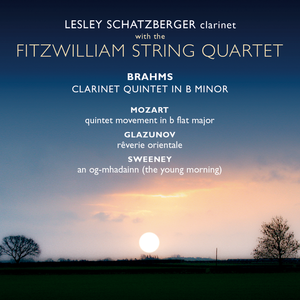Brahms Clarinet Quintet - Lesley Schatzberger and Fitzwilliam String Quartet
FLAC 48kHz / 24bit (Studio Master) | Linn Records CKD 278 [2009] | 647 MB | 5% RAR | MU, RS, FSonic
FLAC 48kHz / 24bit (Studio Master) | Linn Records CKD 278 [2009] | 647 MB | 5% RAR | MU, RS, FSonic
On a bright November weekend in 1993 I travelled to Innsbruck to spend a few days with Rudolph Tutz, whom I had commissioned to make a copy of the A clarinet played by Richard Mühlfeld, the clarinettist who inspired Brahms to write his Clarinet Quintet. Tutz had asked me to spend a little time with him in order to "fine-tune" the instrument before it left the maker's workshop. Full of excitement about the first notes I would be playing on this special instrument, what I actually found on arrival was the boxwood body of the instrument, bare of any of its brass keywork, and not yet stained or varnished. But the transformation over the next three days (and nights!) was fascinating to watch, and I very much felt the assistant and "midwife" in the proceedings. When the taxi arrived to take me back to the airport, Tutz was still working, and I barely caught the flight home.
The original from which my instrument is copied was made for Mühlfeld in the 1870s by the Munich maker Georg Ottensteiner, and it survives, with its B flat partner, in the Staatliche Museen in Meiningen. The unique fingering system was devised by Carl Bärmann, the son of Carl Maria von Weber's inspirational clarinettist Heinrich Bärmann. It was Mühlfeld's playing of a concerto by Weber which had stunned Brahms by its eloquence and beauty in 1891. A firm friendship was formed, and Brahms nicknamed Mühlfeld Fräulein Klarinette, meine Primadonna and the nightingale of the orchestra.
Mühlfeld remained faithful to his Ottensteiner instruments to the end of his life in 1907, despite the fact that the more technically advanced Oehler clarinets, made in heavier ebony wood, were becoming prevalent in Germany and Austria by then. With its straighter bore and lighter wood, the instrument has a less boomy and more focussed quality than later clarinets, with more potential for delicacy and varied colours - well worth the challenges the slightly idiosyncratic fingering system imposes on the modern player!
Tracklist
[1] Clarinet Quintet in B minor, Op.115 Allegro
[2] Clarinet Quintet in B minor, Op.115 Adagio
[3] Clarinet Quintet in B minor, Op.115 Andantino - Presto non assai, ma con sentimento
[4] Clarinet Quintet in B minor, Op.115 Con moto
[5] Quintet movement in B flat major, K.516 (K. Anh.91) Allegro
[6] Rêverie Orientale, Op.14 No.2
[7] An Òg-Mhadainn



